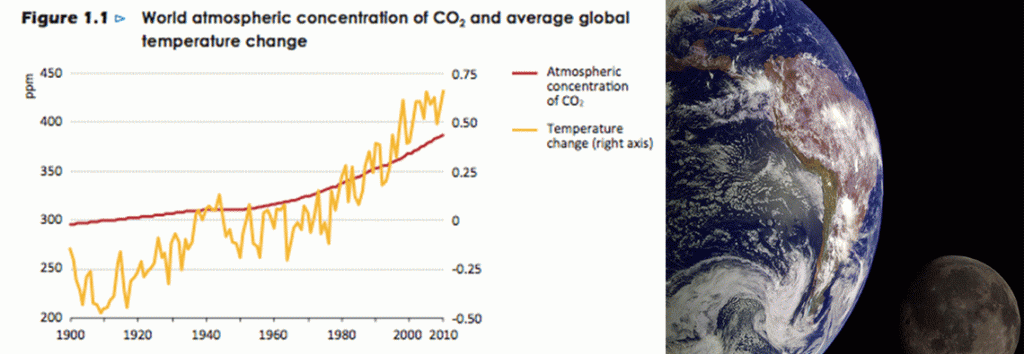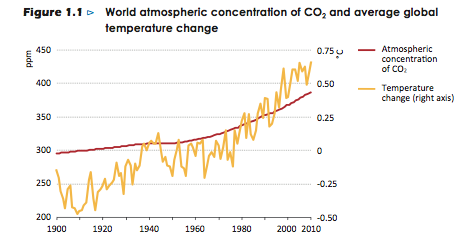Energy Related Emissions Down in the U.S.
The United States’ energy-related carbon dioxide emissions for the first quarter of 2012 were reduced to levels not seen since 1992 according to a 2012 publication by the Energy Information Administration. Emissions in the U.S. were reported to be down 8% from 2011’s first quarter.
The lower levels in the U.S., the EIA states, are attributed to a convergence of atmospheric, consumptive and technological patterns, such as a decline in coal combustion due to milder weather, reduced gasoline consumption and, according to the authors, the low cost of energy generation by natural gas.
Global Emissions Record High
Dr. David Stahle, a professor of Geosciences at the University of Arkansas, told the UA Office for Sustainability that in spite of these reductions the global levels of emissions are at a record high.
“Emissions are led by China, the United States, India, the Russian Federation, and the European Union. This is in spite of the fact that carbon dioxide emissions in the U.S. from energy use have declined,” – Stahle.
Dr. Steve Boss, a professor of Geosciences and Director of the Environmental Dynamics Program, said the 2012 numbers were artifacts of the stalled economy, which is implied in the statement ‘reduced demand for gasoline.’
“The major drop occurred during late 2008 and 2009 when the U.S. and global economy crashed. You can look at emissions data for all nations on the EIA site, and see similar declines in CO2 emissions – a sign of limited industrial output and struggling economies worldwide,” – Boss.
U.S. coal showed an 18% reduction in CO2 emissions, which is the lowest for a year’s first quarter since 1983, and the lowest for any quarter since April through June of 1986. For the 2012 quarter, 90% of the emissions from coal came from the electricity sector. Coal is the biggest contributor to CO2 emissions among common power generation sources.
Dr. Boss warned that emissions are not on a downward trend, but rather a short-term decline.
“Small reductions are seen globally throughout the recession…It would be nice to believe we were on a long-term trajectory to reduce emissions, but we aren’t, not in the U.S. or worldwide.”
Dr. Stahle agreed with Dr. Boss’ assessment. “Carbon dioxide emissions in the U.S. from energy use have declined, but this does not include other greenhouse gas emissions.” He referenced Nature Climate Change’s report which included an article “…by Peters et al in early December 2011 that reported record emissions since a small decline during the 2008 recession. Again this December they reported a new article by the same group which indicates that emissions in 2012 were the highest ever measured.”
The U.S. EIA suggested that the United States is lowering carbon dioxide emissions, and by supporting the natural gas industry rather than coal, the U.S. could continue to reduce emissions. Dr. Stahle contributed that this can also “enhance the energy industry and employment in the U.S.”
GHG a National Priority
Reducing greenhouse gas emissions from power generation is a national priority. Paul Anastas, Ph.D., Assistant Administrator of the Environmental Protection Agency’s Office of Research and Development, said in a memo: “My vision for the future of ORD includes a recognition that the goal of sustainability is our ‘true north,’ that scientific and technological innovation is essential to the success of our mission, that we need to couple our excellence in problem assessment with an equal excellence in solving problems, and that we must act with a sense of urgency. The major challenges to sustainability, human health, and the environment that we face are not incremental problems, and they do not lend themselves to incremental solutions. Addressing climate change…will require innovation.”
No Easy Answers for Greenhouse Gasses
There are no easy answers for reducing greenhouse gas emissions, but identifying the most sustainable solutions is critical to improving all greenhouse gas emissions and preserving natural resources. “Our work must inform, enable, and empower sustainable solutions to the challenges posed to human health and the environment…A diagnosis alone is not a cure, and we must be in the business of facilitating solutions to the environmental problems we face,” Dr. Anastas wrote, “…with a clear enunciation of our path forward, there is nothing we can’t achieve together.”


